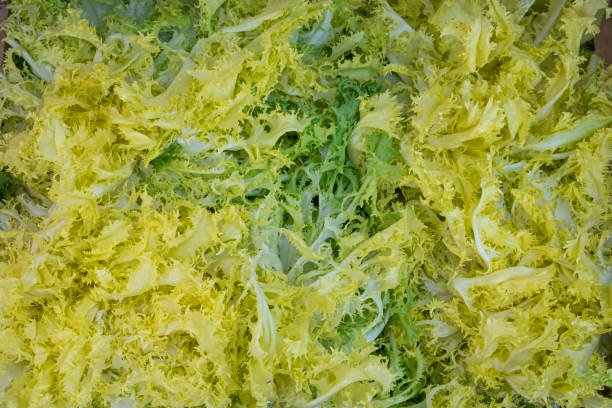Endive and Escarole Pests and Diseases
Endive and Escarole Common Pests
In general, endives do not greatly suffer from pests, but farmers are advised to scout their fields often, monitor their population, and take all preventive measures.
Cutworms (Agrotis spp. and Peridroma sauce)
Black and variegated cutworms are a common problem of endive and escarole crops. The larvae can feed and damage the leaves (and buds) and cut the young seedlings’ stems close to the soil surface. Usually, cutworms remain hidden during the day below the soil. In newly planted endive fields with a severe infestation of cutworms, the damage to the seedling could lead to almost complete crop failure.
The farmers need to scan their fields during the late afternoon or early evening for the larvae that can be grey, black, pink, and green (depending on the species), reach 5 cm (2 inches) in length, and are usually curled in a characteristic ‘C’ shape. To better monitor the insect population, the farmer can use yellow and white traps during spring (to capture the adults). If more than 40 adults have been captured by the end of the spring, the farmer should be prepared to apply necessary control measures in early summer. A deep plowing 2-3 weeks before planting can decrease the population of young larvae on the soil. On the contrary, fields where no-tillage is applied, may have higher pest populations. Crop rotation may be effective but keep in mind to avoid the numerous host species (avoid alfalfa). Chemical control is possible and sometimes necessary in fields with severe problems. Pesticides with active compounds like carbaryl, cyfluthrin, and permethrin can be effective but should be used following the advice of an agronomist and the label directions.
Leafminers (Liriomyza sativae and L. trifolii)
The larvae can dwell on the leaves, creating tunnels. This activity damages the leaf tissue, decreases photosynthetic capacity, and the wounds consist of entry areas for disease infections. Since endives and escaroles are mainly sold as fresh vegetables for raw consumption, such damage on the leaves and heads may lead to the loss of their commercial value.
To avoid any quality loss, the farmer should closely monitor the population of the insect with yellow sticky traps and apply a control measure when the insect/damage amount exceeds the treatment threshold. Chemical control with suitable and registered pesticides should be applied when more than one miner is counted per leaf before the head formation stage of endive/escarole. After that stage, the treatment threshold is 1 miner per leaf per 25 plants. Some active compounds against the insect are pyrethroids, diazinon, and spinosad. You must always consult a licensed agronomist in your area before applying any such product. In the case of small populations of Liriomyza, natural enemies of the pest, like parasitic wasps, can keep it under control. Crop rotation could be helpful, but crops like melon, alfalfa, and cotton should be avoided. Finally, fields with high pest pressure from leafminers should be disked right after the harvest of the endives and escaroles.
Major Diseases of Endive and Escarole
Leaf spots
Like lettuce, endive and escarole are susceptible to both fungal (caused by Septoria, Cercospora, and Microdochium species) and bacterial leaf spots. (Xanthomonas campestris pv. vitians). These pathogens mainly infect mature plants. Usually, the infections are close to harvesting. Symptoms appear as small angular spots on the foliage that are chlorotic at first and turn to expanded necrotic areas later as the disease progresses. Depending on the pathogen, the lesions may have a different appearance (water-soaked, tan, darker, the center falls out, etc.). In some cases, the plant nerves become black, the formation of the heads is affected, and the entire plant collapses. Cool, moist and wet conditions may favor the spread and progress of the diseases.
Disease control begins with proper prevention measures and cultural control. Overhead irrigation must be avoided in areas and times with favorable conditions for the pathogens and with a known disease history. Since the bacteria can be seed-born, using only certified seed and healthy transplants is essential. Endive and escarole farmers are advised to observe their fields often and remove the plants with suspicious symptoms. It is also essential to use proper sanitation, such as tools disinfection every time we touch the plants and avoiding entering the field when the plants are wet.
The general condition of the plants (nutrients and water level, sun exposure) can also boost their immunity. Finally, chemical treatment is used only if the problem is severe and always under supervision from a local licensed agronomist.
Soft rot – Root rot – Damping-off
The disease is caused by species of the Pythium genus (P. tracheiphilum) and is quite common in leafy vegetables like endive, escarole, and lettuce. The pathogens infect all the parts of the plants that are in touch with the soil. Symptoms of the infection include a soft rot that causes a characteristic “melt” (wither) of the young plants, vascular necrosis, and canker on the mature plants.
Disease control begins with proper precautionary measures. These include weed control to eliminate other host species (cruciferous) and proper crop residue management. Additionally, crop rotation with non-host species should be helpful. Over-irrigation and flooding should be avoided since they can favor the disease and increase the damage. Chemical treatment is used only if the problem is severe and always under supervision from a local licensed agronomist.
Further Reading
10 Interesting Facts about Endive and Escarole
Endive and Escarole: Health Benefits and Nutritional Value
Endive & Escarole Plant Information and Environmental Requirements
How to Grow Endive (and Escarole) at Home
How to Grow Endive -Escarole for Profit
Endive (and Escarole) Soil Requirements, Preparation and Planting
Endive and Escarole Water Requirements & Irrigation Systems
Endive and Escarole Fertilization Requirements
Endive and Escarole Blanching, Yield, Harvest and Storage
Endive and Escarole Pests and Diseases
References:










































































